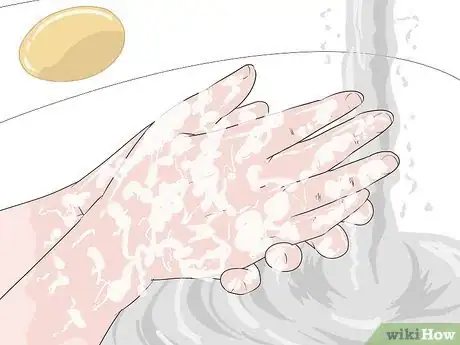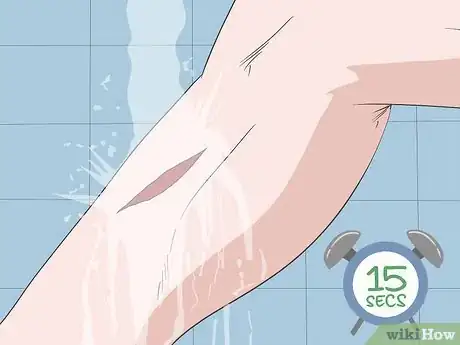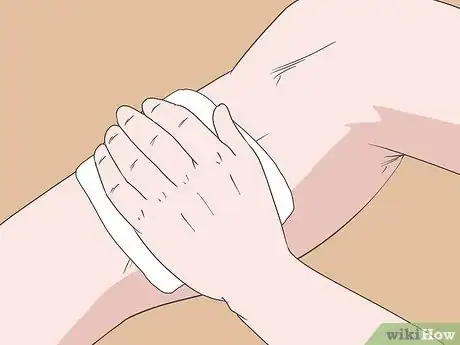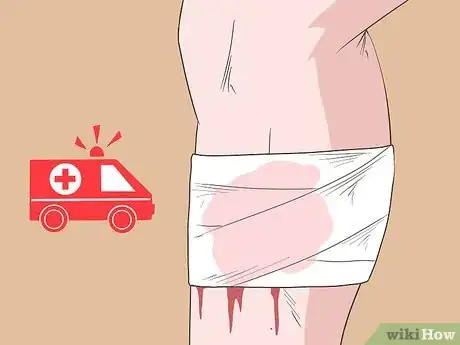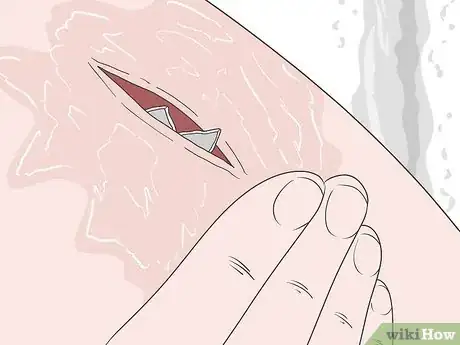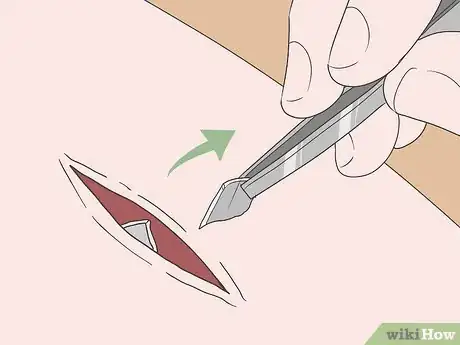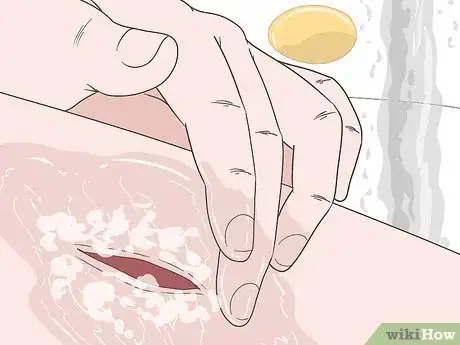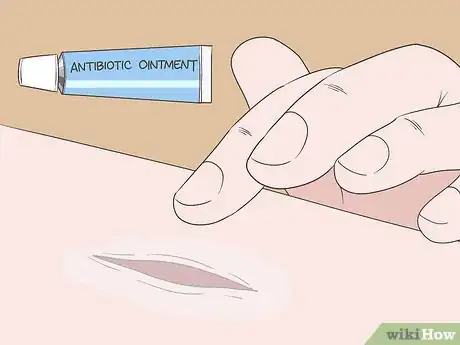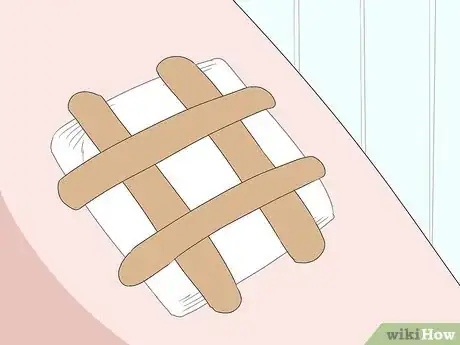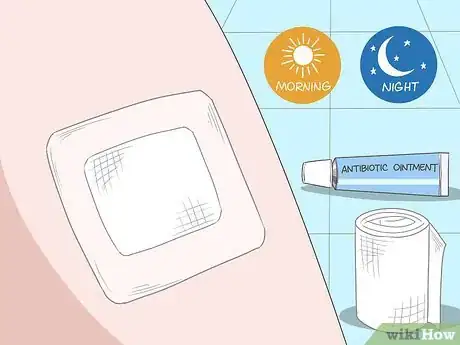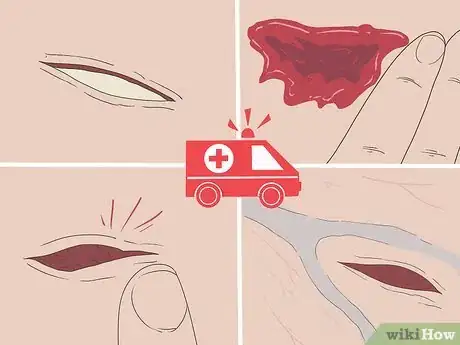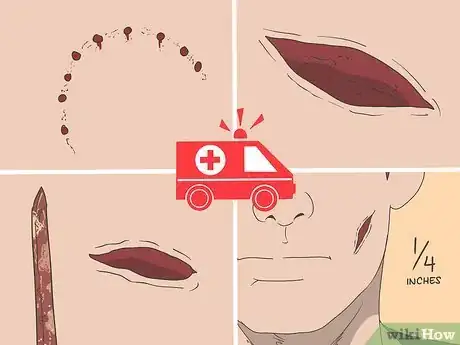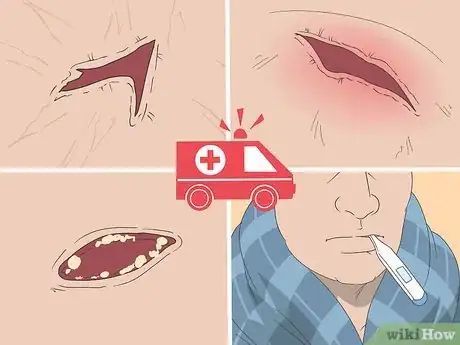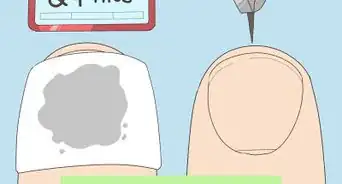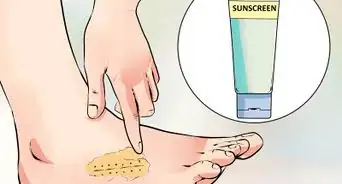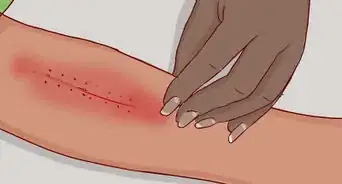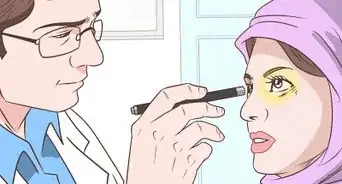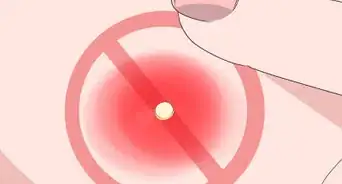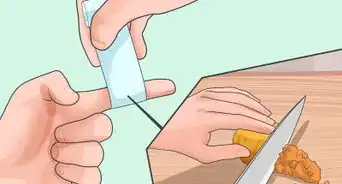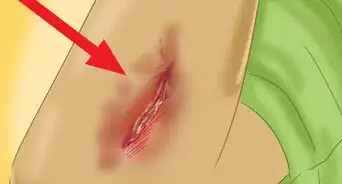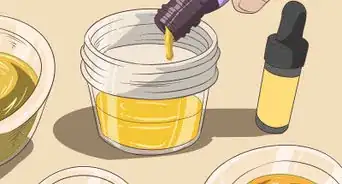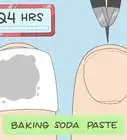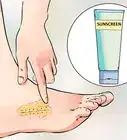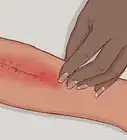This article was medically reviewed by Danielle Jacks, MD. Danielle Jacks, MD is a Surgical Resident at Ochsner Clinic Foundation in New Orleans, Louisiana. She has over six years of experience in general surgery. She received her MD from Oregon Health and Science University in 2016.
This article has been viewed 11,805 times.
If you or someone else has a deep cut, it’s important to stop the bleeding before you attempt to clean it. Then, use basic first aid techniques to clean and dress the wound. As you go through this process, make sure to watch for signs that the wound may require emergency medical treatment, such as profuse bleeding that won’t stop. Deep cuts often require medical care since they are more likely to become infected, result in severe bleeding, or cause damage to muscle, nerves, and tendons. Also, make sure to check the wound daily as it heals to determine if you might need to see a doctor.
Steps
Stopping the Bleeding
-
1Wash and dry your hands before you touch the wound. Use warm running water and mild soap to wash your hands. Then, dry them thoroughly with a clean, dry towel. If you don’t have access to soap and water, use an alcohol-based hand sanitizer instead.[1]
- If you’re caring for someone else’s wound, it’s a good idea to put on a pair of vinyl gloves before you begin.
-
2Rinse the wound under lukewarm water for 10-15 seconds. If the wound is on an arm or leg, move it under a source of running water and keep it there for 10-15 seconds. If the wound is on another part of the body, fill a clean cup with lukewarm water and slowly pour it over the wound. Repeat this 2-3 times to rinse away any blood or superficial debris and make it easier to see the wound.[2]
- Do not put soap on the wound yet or keep it under the water for too long if it’s bleeding. It’s important to stop the bleeding completely before cleaning the wound.
Advertisement -
3Press a clean gauze pad against the wound for 5-10 minutes. Use medium pressure to do this. The bleeding may stop after only a few minutes of applying pressure, or you may need to keep the gauze in place for up to 10 minutes. Check the wound after 5 minutes to see if it is still bleeding. If it is, press the gauze against the wound for another 5 minutes.[3]
- If the wound is on an arm or leg, raise the limb above the level of the person's heart. This may help stop the bleeding faster.
- If you do not have a gauze pad, you could also use a cotton ball, clean paper or cloth towels, or even a rolled up jacket or shirt. Just don’t use your bare hands.
Tip: If blood soaks through the first gauze pad, leave it in place and apply another one over it. Removing the first pad may reopen the wound and cause more bleeding.[4]
-
4Seek emergency medical treatment if the bleeding won’t stop. Call emergency services for an adult whose bleeding does not stop within 10 minutes. If the injured person is a child, contact emergency services if you cannot stop the bleeding within 5 minutes.[5]
Cleaning and Dressing the Wound
-
1Rinse the wound for 5 to 10 minutes if debris is visible. If the wound has visible debris in it, don’t try to pick it out yet. Start by holding the wound under running water to rinse away any superficial debris, such as dirt, glass, or rocks.[6]
- You can use cool or lukewarm water depending on what feels most comfortable for you. Don’t use hot water as this can be painful and increase bloodflow to the area.
-
2Remove any remaining debris with a pair of sterilized tweezers. Dip a pair of tweezers into a cup of rubbing alcohol and leave them there for about 30 seconds. Then, remove the tweezers and let them air dry on a clean paper towel. Use the tweezers to gently pick out any small pieces of remaining debris, such as glass or rocks.[7]
- If there are more than 5 pieces of debris embedded in the wound, seek medical attention to have the wound cleaned.
- Also, do not try to pull out anything that is deeply embedded in the wound. For example, if you have a large piece of glass or metal stuck in the wound, go to an emergency room. Do not try to remove this on your own.
- You could also use your gloved fingers to remove embedded debris from a wound.
-
3Wash the area around the wound with mild soap and water. Do not apply soap directly to the wound. Instead, hold the wound under running water, rub a small amount of mild soap into the skin around the outside of the wound, and then rinse the wound allowing the soap to run over it. Rinse the wound until the soap is completely gone.[8]
- Avoid using any soap that is highly perfumed, antibacterial, or that contains exfoliating beads.
Warning: Don’t pour iodine or hydrogen peroxide on the wound to cleanse it. This may cause irritation and impede wound healing.[9]
-
4Apply an antibacterial ointment to the wound. Dispense a small amount of antibacterial ointment onto a cotton swab and spread it in a thin layer over the wound. Don’t apply the ointment internally. Only spread it across the cut. This will promote faster healing and it may also help to prevent an infection.[10]
- There are also antibacterial sprays available so you don’t have to touch the wound at all. Or you can use a bandage that already has antibacterial ointment on it.
-
5Cover the wound loosely with a clean, non-stick bandage. You can use an adhesive bandage or apply a clean piece of gauze to the wound with a strip of medical tape. Just make sure that the bandage covers the wound completely and allows some air to flow through. This will help to promote healing.[11]
- If you have a butterfly bandage, this can help to keep the edges of the wound together.[12] However, don't use a butterfly bandage if the would appears to be dirty. Otherwise, you may trap the debris inside the wound, which can increase the risk of an infection.
-
6Change your wound dressing twice per day or if it’s wet or dirty. Plan to change your wound dressing once in the morning and again in the evening. However, if you notice that the bandage is wet or that that it has become soiled, remove the soiled dressing immediately, cleanse your wound again, and secure a new dressing.[13]
- Keep a tube of antibacterial ointment and a few bandages with you at all times in case you need to change the dressing on the go.
Seeking Medical Care
-
1Assess the wound to decide if you should seek medical care. In some cases, a deep cut may require emergency medical attention because the wound may be life-threatening if left untreated. Watch for signs that you may need to get emergency medical care for the wound and call emergency services if:[14]
- You can see fat, muscle, or bone.[15]
- The wound will not stop bleeding after applying pressure for 10 minutes.
- You can’t feel or use the injured area.
- You have other injuries that require medical treatment.
- The wound is close to a joint or major blood vessel.
- The wound is too painful to touch or clean properly.[16]
-
2Call your doctor immediately or go to urgent care. Some situations may not require emergency treatment, but it's important to see a doctor as soon as you can. Call your doctor for a same day appointment or go to an urgent care clinic to treat a deep cut if:[17]
- You have been bitten by an animal or human (breaking the skin).
- You haven’t had a tetanus shot in the last 10 years.
- The wound is large or deep.
- The wound is on your face and it’s more than 1⁄4 in (0.64 cm) deep.
- Your wound was caused by a rusty object, nail, or fishhook.
- You have an object or debris embedded in the wound.
Tip: Some doctors may recommend getting a tetanus shot if it’s been more than 5 years since you last had one. Check with your doctor to determine if you should update this vaccination.
-
3Watch for signs of an infection and get prompt treatment. Infections are more common with deep cuts and puncture wounds, so pay attention to the wound over the next 1-2 weeks for any signs of an infection. If you notice any, call your doctor or visit an urgent care clinic the same day. Some symptoms to watch for include:[18]
- Redness or red streaks[19]
- Warmth
- Swelling
- Pain or throbbing in the wound
- Fever
- Pus draining from the wound
Warnings
- Never blow or breathe on an open wound as this can introduce bacteria into it and possibly cause an infection.[20]⧼thumbs_response⧽
Things You’ll Need
Stopping the Bleeding
- Mild soap
- Clean towel
- Vinyl gloves (optional, if caring for someone else’s wound)
- Clean gauze pads
Cleaning and Dressing the Wound
- Mild soap
- Vinyl gloves (optional, if caring for someone else’s wound)
- Tweezers
- Rubbing alcohol
- Antibacterial ointment
- Cotton swabs
- Clean cotton gauze
- Bandages
References
- ↑ https://www.nhs.uk/common-health-questions/accidents-first-aid-and-treatments/how-do-i-clean-a-wound/
- ↑ https://kidshealth.org/en/parents/bleeding.html
- ↑ https://medlineplus.gov/ency/article/000043.htm
- ↑ https://www.nhs.uk/common-health-questions/accidents-first-aid-and-treatments/how-do-i-clean-a-wound/
- ↑ https://kidshealth.org/en/parents/bleeding.html
- ↑ https://www.nhs.uk/common-health-questions/accidents-first-aid-and-treatments/how-do-i-clean-a-wound/
- ↑ https://www.urmc.rochester.edu/encyclopedia/content.aspx?contenttypeid=1&contentid=2978
- ↑ https://www.mayoclinic.org/first-aid/first-aid-cuts/basics/art-20056711
- ↑ https://www.mayoclinic.org/first-aid/first-aid-cuts/basics/art-20056711
- ↑ https://medlineplus.gov/ency/article/000043.htm
- ↑ https://medlineplus.gov/ency/article/000043.htm
- ↑ https://www.urmc.rochester.edu/encyclopedia/content.aspx?contenttypeid=1&contentid=2978
- ↑ https://www.urmc.rochester.edu/encyclopedia/content.aspx?ContentTypeID=90&ContentID=P02830
- ↑ https://medlineplus.gov/ency/article/000043.htm
- ↑ https://www.urmc.rochester.edu/encyclopedia/content.aspx?contenttypeid=1&contentid=2978
- ↑ https://www.nhs.uk/common-health-questions/accidents-first-aid-and-treatments/how-do-i-clean-a-wound/
- ↑ https://medlineplus.gov/ency/article/000043.htm
- ↑ https://medlineplus.gov/ency/article/000043.htm
- ↑ https://www.urmc.rochester.edu/encyclopedia/content.aspx?contenttypeid=1&contentid=2978
- ↑ https://medlineplus.gov/ency/article/000043.htm
